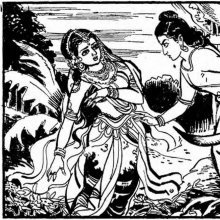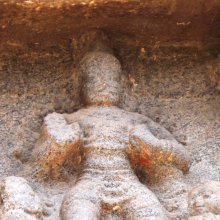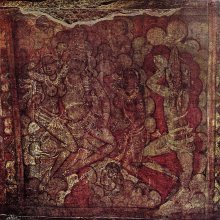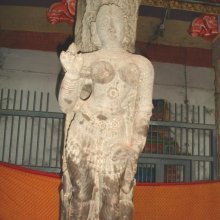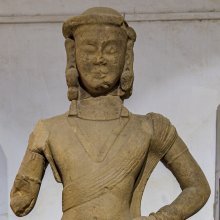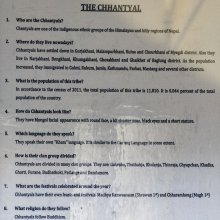Nose: 5 definitions
Introduction:
Nose means something in Hinduism, Sanskrit. If you want to know the exact meaning, history, etymology or English translation of this term then check out the descriptions on this page. Add your comment or reference to a book if you want to contribute to this summary article.
Images (photo gallery)
(+3 more images available)
In Hinduism
Yoga (school of philosophy)
Source: ORA: Amanaska (king of all yogas): A Critical Edition and Annotated Translation by Jason Birch1) Nose (meditation) (i.e., ‘gazing on the tip of the nose’) forms part of the various Teachings or Techniques (saṅketa) on Layayoga, according to the Dattātreyayogaśāstra verse 21-26.—Note: The Dattātreyayogaśāstra’s techniques (saṅketa) of Layayoga can be summarised as meditation on the void, gazing on the tip of the nose, meditating on the back of the head, gazing between the eyebrows, meditating on the forehead and brow, meditating on the two big toes and lying on the ground like a corpse.
2) The Nose is denoted by the Sanskrit term Nāsa, according to the Parākhyatantra verse 14.8-9.—Accordingly, while discussing preliminary practices to make the Yogin ready to undertake the six auxiliaries of Śaiva yoga: “He should adopt one of these [four poses], placing his hands with the palms arranged [facing upwards] in his own lap, expanding his chest evenly. Slightly closing his two eyes, he should focus on the tip of his nose (nāsa). Remaining thus he is fit for yoga and he should then begin its sequence”.

Yoga is originally considered a branch of Hindu philosophy (astika), but both ancient and modern Yoga combine the physical, mental and spiritual. Yoga teaches various physical techniques also known as āsanas (postures), used for various purposes (eg., meditation, contemplation, relaxation).
Gitashastra (science of music)
Source: Shodhganga: Elements of Art and Architecture in the Trtiyakhanda of the Visnudharmottarapurana (gita)The Nose (in Sanskrit: Nāsikā) refers to one of various Organs of Utterance (sthāna), according to Bhattojidīkṣita in his Siddhāntakaumudī.—During the practise of Vocal Music, the proper production of the concerned sound is always considered as very important. Sthāna or ucchāraṇasthāna is the place of articulation of sound. Bhattojidīkṣita in his Siddhāntakaumudī said about ten kinds of sthāna (i.e., the organs of utterance), e.g., nāsikā (nose).
Gitashastra (गीतशास्त्र, gītaśāstra) refers to the ancient Indian science of Music (gita or samgita), which is traditionally divided in Vocal music, Instrumental music and Dance (under the jurisdiction of music). The different elements and technical terms are explained in a wide range of (often Sanskrit) literature.
Natyashastra (theatrics and dramaturgy)
Source: Shodhganga: Elements of Art and Architecture in the Trtiyakhanda of the Visnudharmottarapurana (natya)The Nose refers to one of the minor Body Parts (belonging to the Face) with which are associated various gestures and expressions (in Sanskrit Dramas), as conveyed through Āṅgikābhinaya: one of the four divisions of Abhinaya or “ways to convey or represent one’s emotion to others”, according to the Nāṭyaśāstra and the Viṣṇudharmottarapurāṇa, an ancient Sanskrit text which (being encyclopedic in nature) deals with a variety of cultural topics such as arts, architecture, music, grammar and astronomy.—The āṅgikābhinaya includes the histrionic representation of the limbs which is simply known as physical gestures. The upāṅgas denote different parts of the Face. These are also six in numbers viz., eyes, eyebrows, nose, lower lip, cheeks and chin.
Six kinds of nose movements are accepted in the Viṣṇudharmottarapurāṇa as well as in the Nāṭyaśāstra. These are—
- natā,
- mandā,
- vikṛṣṭā,
- socchvāsā,
- vikūṇitā and
- svābhāvikī.

Natyashastra (नाट्यशास्त्र, nāṭyaśāstra) refers to both the ancient Indian tradition (shastra) of performing arts, (natya—theatrics, drama, dance, music), as well as the name of a Sanskrit work dealing with these subjects. It also teaches the rules for composing Dramatic plays (nataka), construction and performance of Theater, and Poetic works (kavya).
Shilpashastra (iconography)
Source: Shodhganga: Elements of Art and Architecture in the Trtiyakhanda of the Visnudharmottarapurana (shilpa)The Nose is denoted by the Sanskrit term Nāsikā, and represents one of the various body parts whose Measurements should follow the principles of ancient Indian Painting (citra), according to the Viṣṇudharmottarapurāṇa, an ancient Sanskrit text which (being encyclopedic in nature) deals with a variety of cultural topics such as arts, architecture, music, grammar and astronomy.—In the third part of the Viṣṇudharmottarapurāṇa, chapters 35th to 43rd are dedicated to the Painting of different portraits of different kinds of men and women. The measurement of almost all the body parts that should be maintained in a picture have been presented here. For example, the Nose (nāsikā) should be 12 aṅgulas.

Shilpashastra (शिल्पशास्त्र, śilpaśāstra) represents the ancient Indian science (shastra) of creative arts (shilpa) such as sculpture, iconography and painting. Closely related to Vastushastra (architecture), they often share the same literature.
Languages of India and abroad
Kannada-English dictionary
Source: Alar: Kannada-English corpusNose (ನೊಸೆ):—[noun] = ನೊದೆ [node].
Kannada is a Dravidian language (as opposed to the Indo-European language family) mainly spoken in the southwestern region of India.
See also (Relevant definitions)
Starts with: Noseberry, Nosebleed, Nosehullu, Nosekal, Nosema cochinchinensis.
Ends with: Big nose.
Full-text (+1282): Nasika, Ghrana, Nasa, Nasya, Ghona, Nasagra, Nasavamsha, Pinasa, Natha, Nasikagra, Vikunika, Ahaka, Chinnanasya, Gandhanali, Nasyota, Raktapinda, Pancendriya, Kshudranasika, Putinasika, Agranasika.
Relevant text
Search found 340 books and stories containing Nose; (plurals include: Noses). You can also click to the full overview containing English textual excerpts. Below are direct links for the most relevant articles:
Garga Samhita (English) (by Danavir Goswami)
Verse 2.8.26 < [Chapter 8 - Description of Seeing Lord Kṛṣṇa]
Verse 3.8.5 < [Chapter 8 - The Opulences of Śrī Girirāja]
Verse 5.11.5 < [Chapter 11 - The Stories of Kubjā and Kuvalayāpīḍa]
Parables of Rama (by Swami Rama Tirtha)
Story 73 - Infinity < [Chapter X - Maya]
Story 147 - Sensual Pleasure < [Chapter XXIII - Sufferings]
Story 80 - Where lies the Charm? < [Chapter X - Maya]
Bodhisattvacharyavatara (by Andreas Kretschmar)
Text Section 213 < [Khenpo Chöga’s Oral Explanations]
Text Section 51 < [Khenpo Chöga’s Oral Explanations]
Text Section 117 < [Khenpo Chöga’s Oral Explanations]
The Jataka tales [English], Volume 1-6 (by Robert Chalmers)
Jataka 261: Paduma-jātaka < [Book III - Tika-Nipāta]
Jataka 126: Asilakkhaṇa-jātaka < [Book I - Ekanipāta]
Jataka 313: Khantivādi-jātaka < [Volume 3]
The Block < [January-February 1933]
Wanted a Repeat Performance < [January – March, 1996]
On High Cricket & Low Spit < [January – March, 1997]
A Collection of Popular Tales from the Norse and North German (by Peter Christian Asbjørsen)
Related products
(+18 more products available)
